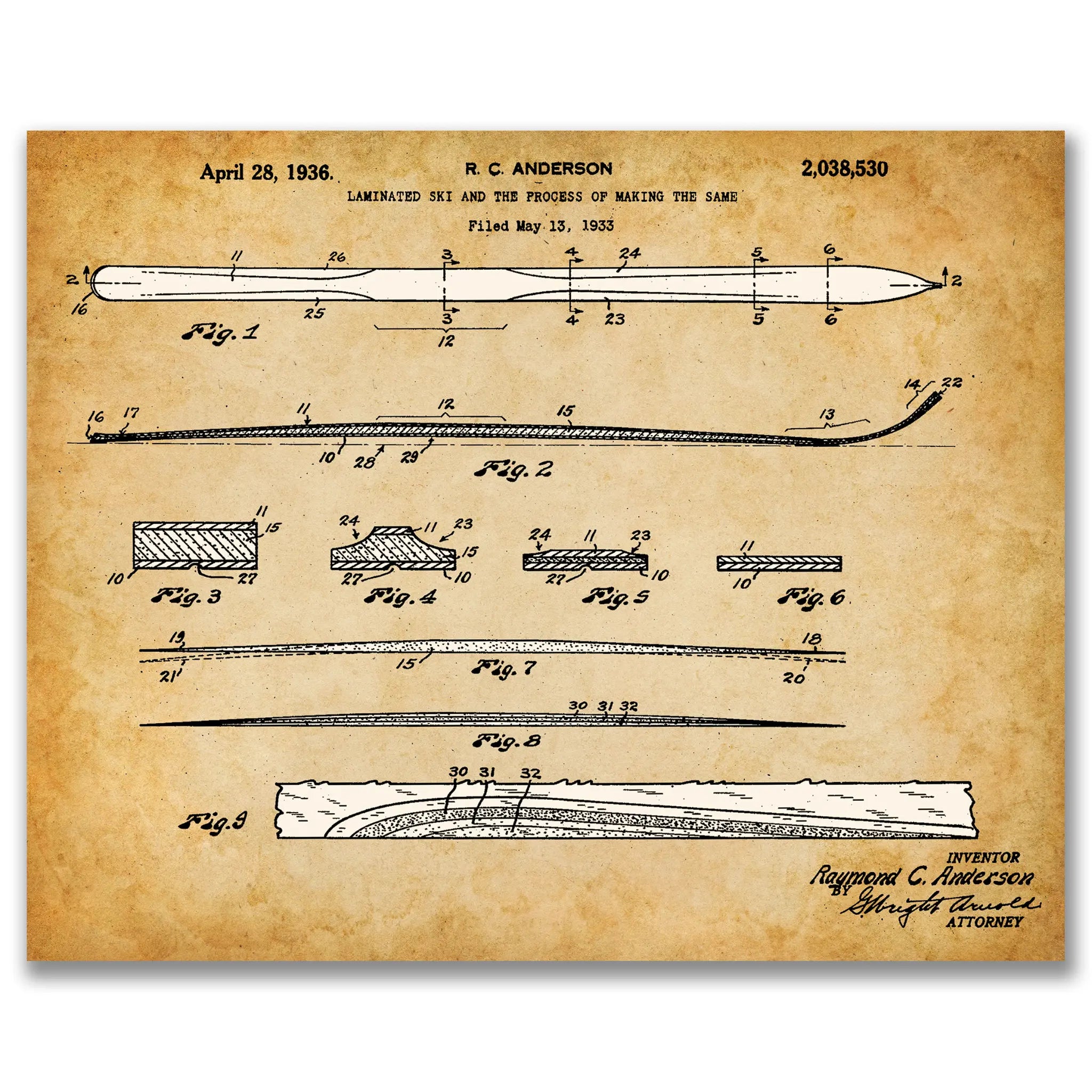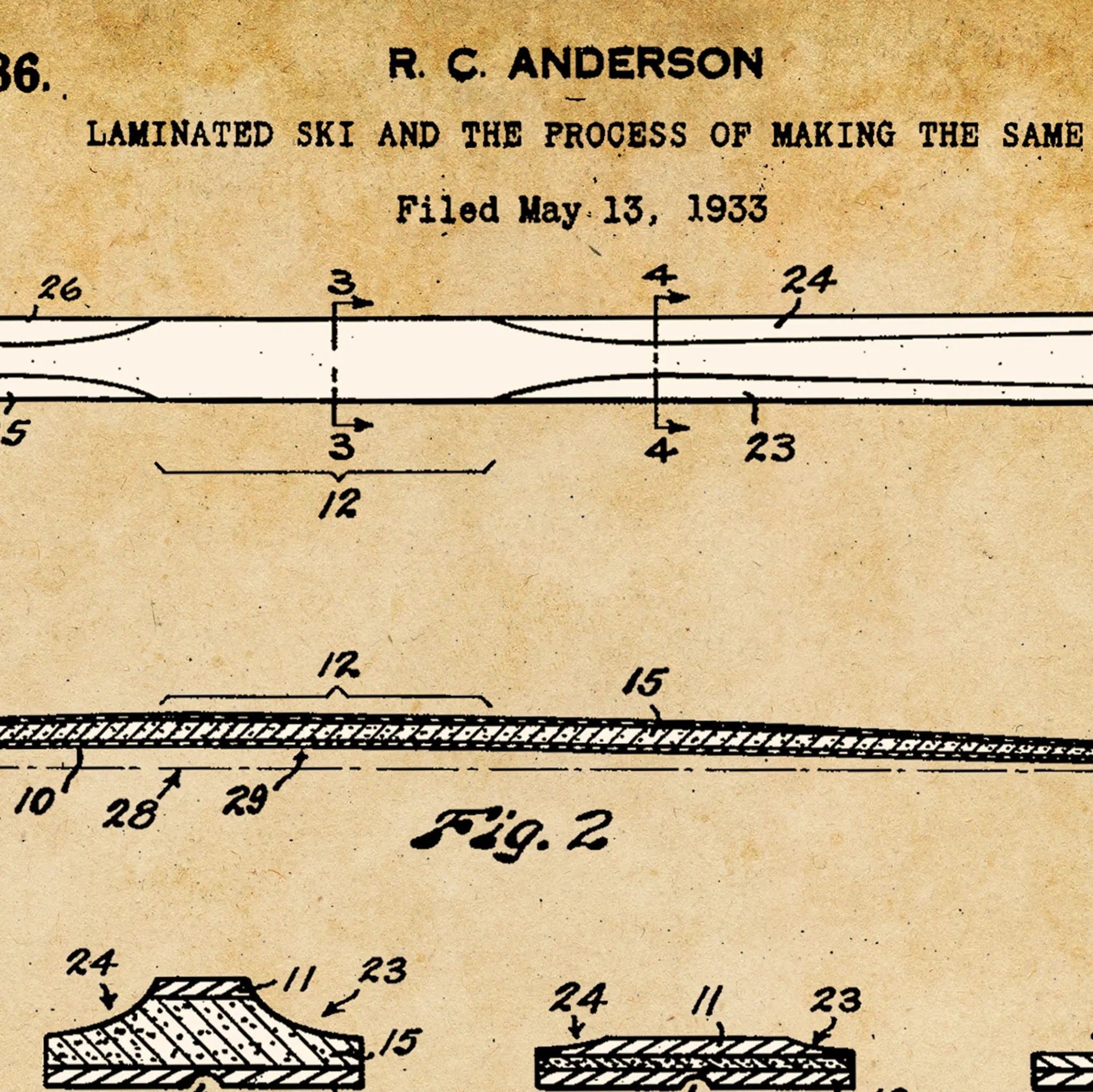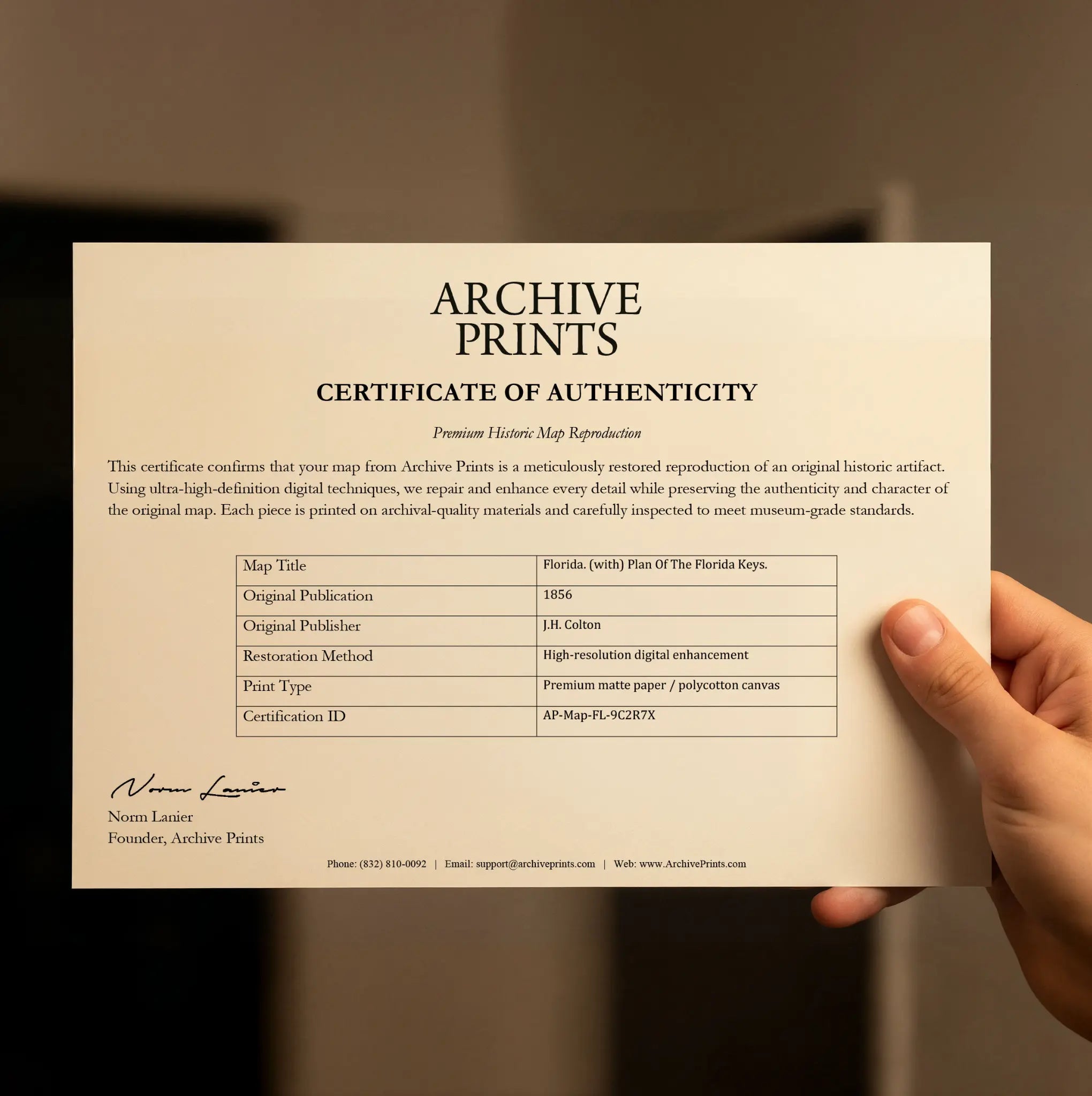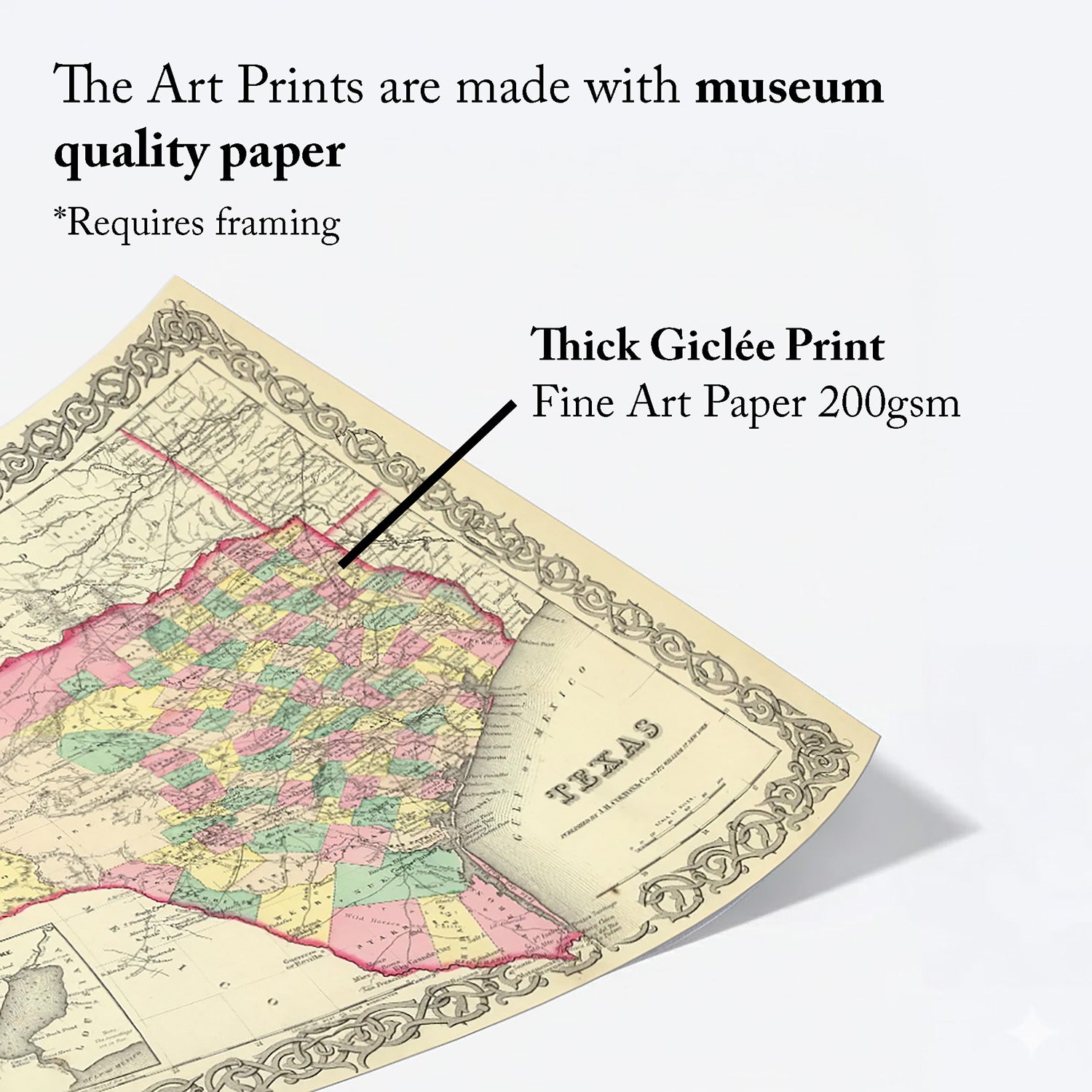







Vintage Ski Patent by R.C. Anderson - Innovation Blueprint
Download Hi-Res Preview
Enter your details and we'll send you a high-resolution version of this map image.
Innovation Blueprint: The Historic 1936 Patent That Revolutionized Ski Construction
Experience the fascinating intersection of engineering innovation and skiing history with this remarkable vintage patent diagram by Raymond C. Anderson, filed on May 13, 1933, and granted on April 28, 1936. This extraordinary technical document reveals the groundbreaking "Laminated Ski and the Process of Making the Same" that fundamentally transformed ski manufacturing and performance, representing a pivotal moment when scientific precision met alpine adventure to create equipment that would define modern skiing.
The composition masterfully showcases the sophisticated engineering thinking that revolutionized ski construction, with detailed technical drawings illustrating Anderson's innovative laminated construction method that replaced traditional solid wood skis with engineered composite designs. The patent diagrams reveal the precise layering techniques, bonding processes, and structural innovations that created skis with superior strength, flexibility, and performance characteristics. Each figure demonstrates different aspects of the manufacturing process, from the initial lamination stages to the final ski profile that would become the foundation for modern ski technology.
This extraordinary patent represents a watershed moment in skiing history when traditional craftsmanship evolved into scientific engineering, establishing the technical foundation for the high-performance skis that enabled the sport's explosive growth and technical advancement. The document embodies the innovative spirit of American engineering during the 1930s, when inventors like Anderson were applying industrial manufacturing techniques to recreational equipment, creating products that would democratize skiing by making it more accessible and enjoyable for recreational skiers while enabling competitive athletes to achieve new levels of performance.
The technical specifications tell the story of skiing's transformation from artisanal craft to precision manufacturing, when the marriage of engineering principles and mountain sports created equipment that could withstand the demands of increasingly challenging terrain and aggressive skiing techniques. The patent captures the essence of innovation that characterized the golden age of American invention, where practical problem-solving met recreational passion to create solutions that would influence an entire industry and sport for generations to come.
From the historical significance of the patent documentation to the authentic representation of 1930s technical illustration, this document serves as both engineering artifact and artistic celebration of American innovation in recreational equipment design. The combination of technical precision, historical importance, and visual appeal creates a piece that appeals to collectors of vintage patents, skiing enthusiasts, engineering history buffs, and anyone who appreciates the intersection of technical innovation and recreational sports. Perfect for ski lodges, engineering offices, patent collections, or any space that celebrates the ingenuity and precision that drives technological advancement.
Each reproduction includes a certificate of authenticity, detailing the historical significance of this groundbreaking ski patent and the meticulous restoration process. Printed on heavyweight archival paper or premium canvas, every technical detail is preserved with museum-quality clarity through expert digital restoration.
For protection and presentation, paper prints arrive rolled in sturdy mailing tubes, while canvas prints come gallery-wrapped on solid pine stretcher bars with pre-installed hanging hardware—ready to display immediately.
Bring home this inspiring celebration of engineering innovation and let this blueprint of skiing advancement inspire your own appreciation for the technical precision and creative problem-solving that transformed recreational equipment and enabled generations of skiers to pursue their mountain adventures with confidence and performance. Perfect for anyone who understands that the best innovations combine technical excellence with practical application to enhance human experience and achievement.
The Photo Story
This document, dated April 28, 1936, is the U.S. Patent for the 'Laminated Ski and the Process of Making the Same,' invented by Raymond C. Anderson of Seattle, Washington. It represents a monumental leap forward in ski technology, a shift from the solid hickory skis of the past to the multi-layered, engineered skis that would dominate the sport for decades to come.
Before Anderson's invention, skis were typically made from a single piece of wood, which was prone to warping, breaking, and inconsistent flex. Anderson's revolutionary idea, detailed in these intricate drawings, was to construct a ski from multiple layers of wood, with the grain of each layer oriented in different directions. This laminated construction, as shown in Figures 3 through 6, created a ski that was not only stronger and more durable but also had a more uniform and predictable flex pattern, giving skiers unprecedented control.
Figure 1 shows the top-down view of the ski, highlighting its classic shape, while Figure 2 illustrates the side profile, including the graceful upward curve of the tip. Figures 7, 8, and 9 delve into the heart of the innovation, showing the different layers and how they are bonded together. Anderson's design was not just about strength; it was about performance. By carefully selecting different types of wood and arranging them in a specific order, he could fine-tune the ski's characteristics, creating a product that was both a piece of industrial design and a finely crafted sporting instrument.
'The Laminated Ski' is a tribute to the brilliant engineering that has always been at the heart of skiing's evolution. It's a reminder that every turn we make on modern skis is thanks to the vision of pioneers like Raymond C. Anderson, who saw a better way to build a ski and, in doing so, helped to shape the future of the sport. This patent is a foundational document in the history of skiing, as important as any race ever won or any peak ever conquered.
Each bottle in these crates once represented risk and profit, carried in under the cover of night or hidden in false walls of warehouses. Raids like this one were victories for the dry cause, but also fueled resentment and ingenuity among those determined to resist. What the agents saw as contraband, others saw as livelihood—or even liberty.
The photograph is a study in contrast: order imposed upon chaos, law set against defiance. It captures not only the sheer scale of enforcement but also the futility of trying to bottle up demand. The walls of boxes stand like a monument, not to victory, but to the resilience of a society unwilling to surrender its pleasures.
“Confiscated” freezes the moment of triumph claimed by enforcers but questioned by history, a reminder that law can smash a crate but rarely empties the thirst inside it.
Materials
Hand‑Stretched Canvas: If you choose canvas, we use a premium cotton‑poly blend stretched over solid pine frames. Each canvas is carefully hand‑stretched for a tight, gallery‑quality finish that's ready to hang right out of the box.
Vivid, Fade‑Resistant Inks: We use professional‑grade inks that are UV‑resistant, so your print retains its rich colors even when displayed in bright rooms.
Expert Restoration: Every patent diagram is digitally restored by skilled artisans. We preserve the character of the original while enhancing clarity, so you see the technical details as they were meant to be seen.
Secure Packaging: Paper prints are rolled in heavy‑duty mailing tubes, and canvases are cushioned in reinforced boxes to ensure they arrive in pristine condition.
Choosing one of our prints means investing in craftsmanship. We combine historical authenticity with modern print technology and premium materials, giving you a work of art built to stand the test of time.
Choose options








Why Choose Us?
| Feature | Us | Competitor A | Competitor B |
|---|---|---|---|
| Hand Crafted | |||
| Museum Quality | |||
| 100 Year Guarantee | |||
| Restored by Hand | |||
| Certificate of Authenticity |

Art Prints
Archival quality colors. Best option if you'd like to frame it yourself

The Best Materials
We hand-stretched our canvas on solid American-grown pine stretcher bars. We use quality canvas and fade-resistant inks to create the lasting art. Canvases come with hardware already installed and ready to hang.
Need help?
Frequently Asked Questions
Order
All of our maps are meticulously restored reproductions of historic originals. Each piece is digitally repaired and color-corrected to bring out the finest details while preserving its authentic, vintage character.
Yes. All Archive Prints products are printed to order in the USA with archival materials.
We offer two premium formats:
- High-Quality Paper Posters – Printed on thick, archival-grade matte paper for rich, vibrant detail.
- Hand-Stretched Canvas Prints – Printed on premium polycotton canvas and mounted on 1.5" solid American pine stretcher bars for a gallery-quality finish.
We carefully digitally restore each map to enhance clarity and color while preserving its original look and historic charm. You’ll enjoy sharp details and a timeless vintage aesthetic that feels true to the original piece.
Currently, we don’t offer framing or personalization. However, our posters are printed in standard sizes, making it easy to find a ready-made frame. For a polished, gallery-style look, our stretched canvas prints arrive ready to hang right out of the box.
Yes! We offer free shipping on all products within the United States. Each map is carefully packaged to ensure it arrives in perfect condition.
If you’re not completely satisfied, you can return your order in new condition for a full refund. Return shipping costs are the responsibility of the customer.
Absolutely! Our maps make thoughtful, one-of-a-kind gifts for history lovers, map collectors, or anyone looking to add vintage character to their home or office. Choose between paper prints for framing or stretched canvas for a ready-to-hang presentation.
- Paper Posters → Shipped in durable, protective tubes to prevent creasing.
- Canvas Prints → Carefully wrapped, padded, and boxed to ensure safe delivery.
Our maps look stunning in a variety of settings, including:
- Living rooms and home offices
- Libraries and studies
- Corporate offices and conference rooms
- Restaurants, cafes, and boutique spaces
